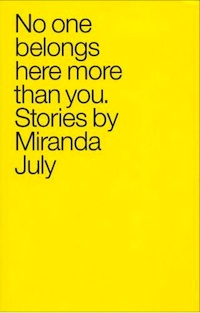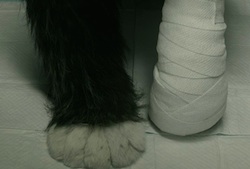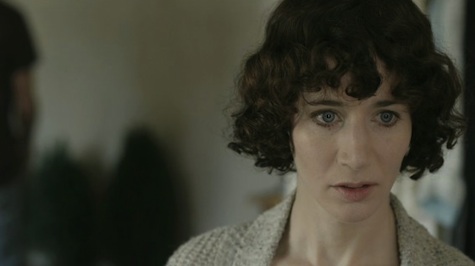A recent satire from The Onion poked fun at the aggressive quirkiness of writer/actor/artist Miranda July by having Congress collectively wonder what her “whole thing was.” I enjoyed this piece a lot, because as good parody should, it appealed to both the haters and the lovers. Like a lot of younger writers with big personalities, Miranda July is easy to make fun of, mostly because she’s so unique. Here’s an example: a favorite game in the Tor.com offices is imagining Miranda July as Padme Amidala instead of Natalie Portman, complete with kooky July-isms. Like when Obi-Wan tells Padme about Anakin turning to the dark side, Padme/July interrupts him saying “Why can’t I have a robe like that? They look so comfortable. Are they comfortable? If the dark side is like a comfortable robe, then I want one.” (Do this game right now in your head. It’s fun.)
But the thing is, all of this prodding and joking around wouldn’t exist if Miranda July wasn’t kind of a great writer. And fans of genre-bending stuff should love her. Here’s why.
Probably best known for her films Me and You and Everyone We Know (2003) and The Future (2011) July also has a couple books out there. The book a fan of genre fiction should be most interested in is her 2007 release No One Belongs Here More Than You, a collection of short stories. If find myself talking about short story collections a lot in Genre in the Mainstream and I think that’s because I find them more accessible than novels when trying out a new author. If you think you might be annoyed with Miranda July’s brand of sarcasm or twee social observations, the stories in No One Belongs Here More Than You might turn you around. Best of all, like Etgar Keret, they’re all fairly brief and breathlessly written, so if it turns out to not be your thing, you’ve wasted almost no time.
The most appealing story in the collection with science fiction leanings is called “Making Love in 2003.” In it, a young struggling writer has gambled her entire life on a promise from an old professor who told her to get in touch when she finished her book. The story takes some interesting turns, beginning with the fact that the narrator finds herself waiting in her old professor’s house with the man’s wife. The wife character is revealed casually to be Madeleine L’Engle, who tells the narrator she is hard at work on a sequel to A Swiftly Tilting Planet. Now, this story isn’t a period piece, in fact, it appears to be set in 2003. In the real world, there is no direct sequel to A Swiftly Tilting Planet, with closest example being An Acceptable Time, which was written in 1989. The L’Engle of our universe would probably not have been writing this “sequel” in 2003, nor is this character necessarily a real portrait of the famous writer. Instead, “Madeleine L’Engle” is a deftly magical device, which transports the reader into a story in which things are both literal and not literal at the same time. (July inserts a note at the end that both L’Engle and the husband character are complete fictions.)
 The story itself is ultimately about the narrator feeling directionless while dealing with the notion that a non-corporeal dark-blob like entity took her virginity. July goes to decent lengths here to convince us that the narrator is telling the truth and that the dark blob entity is a real thing. If any thing, the blob is a more realized character than the faux-Madeleine L’Engle insofar as the character seems to have properties which make it more human than any of the other characters in the story. July pulls this off with this passage in which the entity is introduced:
The story itself is ultimately about the narrator feeling directionless while dealing with the notion that a non-corporeal dark-blob like entity took her virginity. July goes to decent lengths here to convince us that the narrator is telling the truth and that the dark blob entity is a real thing. If any thing, the blob is a more realized character than the faux-Madeleine L’Engle insofar as the character seems to have properties which make it more human than any of the other characters in the story. July pulls this off with this passage in which the entity is introduced:
When I was fifteen, a dark shape came into my room at night. It was dark, but it glowed, which is the first of many facts you will have to tackle with your imagination. It wasn’t in the shape of a person, but right away I knew it was like a person in everyone way except for how it looked. As it turns out, our looks are not the main thing that makes us human.
Our looks are not the main thing that makes us human! Science fiction writers from Dick to Asimov to Butler to Ron Moore with all the Battlestar Cylon-musings have been tackling this one with their imaginations for years! In this way, I feel like Miranda July would be in a great position to write out-and-out science fiction, insofar as it seem like she gets the central questions most good SF asks. Like- what does it mean to be human? What would it mean in an other, perhaps imagined context? And in some ways, with the release of her most recent film, July has entered that realm. Could I call The Future a science fiction film in the same way I claim Woody Allen’s Midnight In Paris is a science fiction film? No. In Midnight in Paris, time travel creates the conflicts, which the character explores. Further, the time-travel is proven to be literal time travel because the results of the main characters past-shenanigans are made evidence in a diary found in the present. July’s The Future doesn’t have a science fiction concept at its core, but it does use fantastical trappings to make its points.
 A pound-cat named Paw-Paw narrates much of The Future, and if you’re not on board for a movie with a talking cat with a cutesy voice (also played by July!), then you’re already in trouble. But Paw-Paw’s not the only thing that speaks in The Future. The moon itself also talks to another major character, and for a long period time appears to actually stop in the film, and the characters live inside of two possible worlds. In this way, July uses high-concept speculative fiction not as her central conflicts, but instead to illustrate her conflicts. Is all the time-stopping stuff in The Future or the dark shape from “Making Love in 2003” all in the mind of the narrator? Perhaps. But just as Dumbledore said to Harry Potter in the The Deathly Hallows, something happening only in one’s mind doesn’t make it any less real.
A pound-cat named Paw-Paw narrates much of The Future, and if you’re not on board for a movie with a talking cat with a cutesy voice (also played by July!), then you’re already in trouble. But Paw-Paw’s not the only thing that speaks in The Future. The moon itself also talks to another major character, and for a long period time appears to actually stop in the film, and the characters live inside of two possible worlds. In this way, July uses high-concept speculative fiction not as her central conflicts, but instead to illustrate her conflicts. Is all the time-stopping stuff in The Future or the dark shape from “Making Love in 2003” all in the mind of the narrator? Perhaps. But just as Dumbledore said to Harry Potter in the The Deathly Hallows, something happening only in one’s mind doesn’t make it any less real.
So, if the SF elements in Miranda July’s stories or films only exist in the minds of the characters, and every single character is an unreliable narrator, it might not make any of her work out-right genre fiction. However, her motivations to employ genre-fiction don’t come from any cynical place, or desire to be strange. They all seem genuine and spot-on. I like to think Asimov wrote of his robots because they haunted his dreams. And Madeleine L’Engle couldn’t get tesseracts out of her head.
Miranda July is probably haunted by talking cats and dark blobs. If you can see how all of this connects, and you let yourself go along with it, the writing of Miranda July will feel like a secret nerd pleasure hiding in plain sight.
Ryan Britt is the staff writer for Tor.com.










